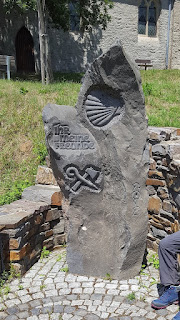 |
| Mr. Mouse at Schloss Stolzenfels (Stolzenfels Castle). Note the scallop shell hanging off the pack on the left. |
The distance that day was 20 km., with 500 m. elevation gain. It was one of the easier days, pleasantly cool and the elevation gain was spread through the day.
We were delighted to find that the signs for the Camino were abundant - in fact, we found signs for the Mosel Camino (yellow shell on blue) and the Left-Rhine Camino (yellow comet on blue). The Left-Rhine Camino (link in German) starts in Bingen and joins the Mosel Camino near Stolzenfels. Bingen is the town where Hildegard of Bingen founded a monastery, composed her beautiful music and wrote her plays during the 11th and early part of the 12th century,
The Mosel Camino signage was finished only in 2006 but, really, nobody can know how the pilgrims of old walked from Koblenz to Trier on their way to Santiago de Compostela. It's safe to assume that the pilgrims usually spent the nights along the river in a village or small town just like we did, and the Mosel Camino makes that easy to do. In fact, it's often possible to be in a town for a nice lunch as well.
Hiking in America is completely different. There is an expectation that you will camp if you go overnight, carrying your own tent, sleeping bag, small camp stove, and food, and cooking your own meals. So in America, hiking is more about experiencing wilderness. In Europe, its more about being outdoors and moving through the world, both the civilized part and the part where animals make their homes, as people have done for thousands of years, namely on foot.
 |
| Fledermaus Sommer-Quartier (Bat Summer Lodging) |
 |
| Mosel Camino Bird House |
The downside to a Nutzwald is that the trees don't get old, and don't have time to get the nesting holes for the birds. That means the bird houses are probably welcomed by the birds - and I don't think they mind the signs.
 |
| Forest Path |
 |
| Picking raspberries |
From there came a steep downhill past a set of Stations of the Cross sculptures. I was very glad to have packed my collapsible hiking poles - I didn't use them much, but they saved me from an undignified descent on all fours in a few cases. The soil along the Mosel is often slate or sand, so it was important to be careful.
Many of the small chapels, churches and other religious areas have Stations of the Cross walks along the way. These are sculptural representations of small vignettes from the story of Jesus' crucifixion taken from the Gospels. In area around where I grew up, in Unterfranken I don't remember any publicly accessible Stations of the Cross (most Catholic churches have them on the interior walls) probably due to the influence of the Reformation and subsequent civic unrest during the Thirty Years War.
In the area of the Rheinland along the Mosel Camino, the few communities that converted to Protestantism were forced to convert back to Catholicism after the first battles of the Thirty Years War which the Catholics won. Franconia, in contrast, was a patchwork quilt of Catholic and Protestant villages. So public displays, which were a common part of Catholic religious practice during the Middle Ages and of which outdoor Stations of the Cross are one, fell out of use in Unterfranken during the century between the mid 1500s to mid 1600s, due to the high probability that they would trigger confrontations between Catholic and Protestant villagers, whereas they continued in the Rheinland.
Other religious sculptures were in evidence everywhere. Small shrines with the Virgin Mary might be embedded in an old gate, like the one above.
What's puzzling is that today the churches in Germany are quite empty, but I sensed an undertone of the old faith along the Camino. Rheinland-Pfalz is pretty much completely Catholic, and something of those centuries of living with a faith can still be felt. Much more subtle than some of the in-your-face Christianity one can encounter in the US. A private affair between people and God, or Mary.
After the descent we first arrived back at the river in Alken and rewarded ourselves with a stop at an ice cream shop. Most ice cream shops in Germany have a collection of ice specialties, like ice cream sundays in the US but more elaborate. Mr. Mouse had Spaghettieis, a specialty that looks like a plate of spaghetti including the tomato sauce (crushed strawberries) and parmesan cheese (ground coconut), and I had an Eissplittertorte, specialty of the cafe where we stopped. The picture below is a screen shot of Spaghettieis from the Internet. Mr. Mouse ordered his Spaghettieis with chocolate ice cream, which made it look more like whole wheat pasta.
We still had a few kilometers to our hotel in Löf on the other side of the river. But no matter. We now had the confidence that we could do this (probably) and it was a nice afternoon to walk.
Our hotel was big, and filled with vacationers. Many were riding bikes - often e-bikes - along the Mosel to burn off at least some of the calories they would later consume in form of an excellent meal. After the daily shower drill - wash socks, wash T-shirt - we put on clean clothes from our suitcase which arrived at the hotel almost the same time we did. And a little later we were fortunate to have our brother-in-law meet us at the hotel. We spent a very pleasant evening sitting outside, catching up on the family news, looking at the Mosel, and eating an excellent meal. Then we read a bit, but the day on the trail had made us tired and we were asleep before 10.





